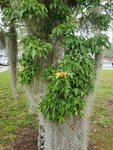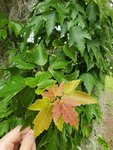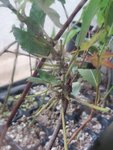jeanluc83
Omono
The biggest down side of red maples, acer rubrum, is the huge internode length. I have a thought on how to handle this but have not had a chance to try my theory. I'll say it again that this is untested on my part.
My idea is to treat them similar to JBP. Since the first push of growth is so long why not just get rid of it in favor of the shorter growth you get later in the season. I would let the shoots extend until they have just started to harden off then cut back to the original node. This could be an extreme form of defoliation similar to hedge trimming but more selective. The next push of growth would have shorter internodes (maybe). It may be possible that the tree would go into survival mode and try to push lots of growth with even longer internodes. That is where the testing needs to be done.
The other part of the equation would be the proper timing for fertilizer application. My thought on this would be to fertilize heavily in the spring and possibly late fall but stop fertilizing after the cut back.
Do you think my idea has merit (it could even be an established technique for all I know)? For everyone out there growing red maple how do you control internode length?
My idea is to treat them similar to JBP. Since the first push of growth is so long why not just get rid of it in favor of the shorter growth you get later in the season. I would let the shoots extend until they have just started to harden off then cut back to the original node. This could be an extreme form of defoliation similar to hedge trimming but more selective. The next push of growth would have shorter internodes (maybe). It may be possible that the tree would go into survival mode and try to push lots of growth with even longer internodes. That is where the testing needs to be done.
The other part of the equation would be the proper timing for fertilizer application. My thought on this would be to fertilize heavily in the spring and possibly late fall but stop fertilizing after the cut back.
Do you think my idea has merit (it could even be an established technique for all I know)? For everyone out there growing red maple how do you control internode length?








